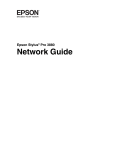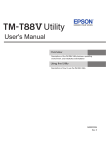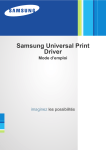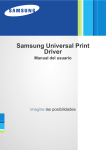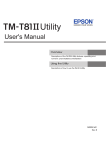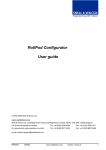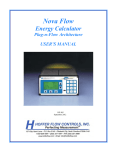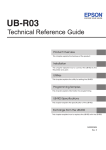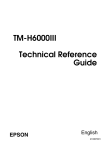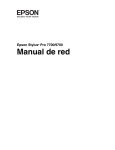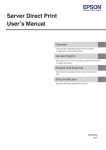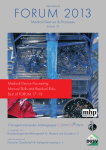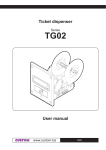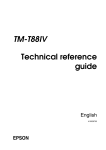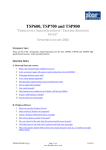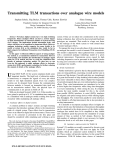Download BA-T500II Utility User`s Manual
Transcript
Utility User's Manual Overview Descriptions of the BA-T500II Utility features, operating environment, and installation/uninstallation Using the Utility Descriptions of how to use the BA-T500II Utility M00026602 Rev.C Cautions • No part of this document may be reproduced, stored in a retrieval system, or transmitted in any form or by any means, electronic, mechanical, photocopying, recording, or otherwise, without the prior written permission of Seiko Epson Corporation. • The contents of this document are subject to change without notice. Please contact us for the latest information. • While every precaution has taken in the preparation of this document, Seiko Epson Corporation assumes no responsibility for errors or omissions. • Neither is any liability assumed for damages resulting from the use of the information contained herein. • Neither Seiko Epson Corporation nor its affiliates shall be liable to the purchaser of this product or third parties for damages, losses, costs, or expenses incurred by the purchaser or third parties as a result of: accident, misuse, or abuse of this product or unauthorized modifications, repairs, or alterations to this product, or (excluding the U.S.) failure to strictly comply with Seiko Epson Corporation’s operating and maintenance instructions. • Seiko Epson Corporation shall not be liable against any damages or problems arising from the use of any options or any consumable products other than those designated as Original EPSON Products or EPSON Approved Products by Seiko Epson Corporation. Trademarks EPSON and ESC/POS are registered trademarks of Seiko Epson Corporation in the U.S. and other countries. MS-DOS, Microsoft , Win32, Windows, Windows Vista, Windows 7TM, and Windows Server are either registered trademarks or trademarks of Microsoft Corporation in the United States and other countries. 2 For Safety Key to Symbols The symbols in this manual are identified by their level of importance, as defined below. Read the following carefully before handling the product. Provides information that must be observed to avoid damage to your equipment or a malfunction. Provides important information and useful tips. Restriction of Use When this product is used for applications requiring high reliability/safety such as transportation devices related to aviation, rail, marine, automotive etc.; disaster prevention devices; various safety devices etc; or functional/precision devices etc, you should use this product only after giving consideration to including fail‐safes and redundancies into your design to maintain safety and total system reliability. Because this product was not intended for use in applications requiring extremely high reliability/safety such as aerospace equipment, main communication equipment, nuclear power control equipment, or medical equipment related to direct medical care etc, please make your own judgment on this product’s suitability after a full evaluation. About this Manual Aim of the Manual This manual presents information that is necessary information for using the BA‐T500II Utility. Manual Content The manual is made up of the following sections: Chapter 1 Overview Chapter 2 Using the Utility 3 Contents ■ For Safety .............................................................................................................................. 3 Key to Symbols........................................................................................................................................3 ■ Restriction of Use .................................................................................................................. 3 ■ About this Manual ................................................................................................................ 3 Aim of the Manual .................................................................................................................................3 Manual Content .....................................................................................................................................3 ■ Contents................................................................................................................................ 4 Overview ........................................................................................5 ■ Overview............................................................................................................................... 5 ■ Support OS ............................................................................................................................ 5 ■ Installation............................................................................................................................. 6 ■ Uninstallation ........................................................................................................................ 7 ■ Differences Depending on the OS...................................................................................... 8 Using the Utility ...............................................................................9 ■ Starting the BA-T500II Utility ................................................................................................. 9 Starting the BA-T500II Utility....................................................................................................................9 Adding a Communication Port and Starting the BA-T500II Utility ...................................................11 ■ Current Settings .................................................................................................................. 14 ■ Operation Check ............................................................................................................... 16 ■ Storing Logos ...................................................................................................................... 17 Adding a Logo......................................................................................................................................18 ■ Printing Control Settings..................................................................................................... 22 ■ Font ...................................................................................................................................... 23 ■ Communication I/F Settings.............................................................................................. 24 ■ Setting Backup/Restore ..................................................................................................... 27 Saving the Printer Settings to a File.....................................................................................................27 Restore the Settings to the Printer ......................................................................................................28 ■ Acknowledgements .......................................................................................................... 30 4 Chapter 1 Overview Overview This chapter describes the specifications of BA-T500II Utility. Overview BA-T500II Utility is a dedicated utility for the BA-T500II printer to check and configure the BA-T500II’s parameters. It also allows you to configure the IP address of a printer through the Ethernet connection. The utility has the following functions: ❏ For general users Operation Check (page 16) Storing Logos (page 17) 1 ❏ For printer administrators Printing Control Settings (page 22) Font Settings (page 23) Communication I/F Settings (page 24) Setting Backup/Restore (page 27) Support OS ❏ Windows XP (32 bit) ❏ Windows Vista (32 bit/ 64 bit) ❏ Windows 7 (32 bit/ 64 bit) ❏ Windows Embedded for Point of Service ❏ Windows Embedded POSReady 2009 ❏ Windows Server 2008 (32 bit/ 64 bit) ❏ Windows Server 2008 R2 (64 bit) 5 Installation Install it with the administrator authority. 1 When the “User Account Control” screen appears, click the [Continue] button. 2 The “EPSON BA-T500II Utility Ver.x.xx - InstallShield Wizard” screen appears. Then click the [Next] button. 3 The “License Agreement” screen appears. Read the content and select the “I accept the terms of the license agreement”. Then click the [Next] button. 4 5 6 Double-click "BA-T500IIUtilityXXX.exe" to start the installer. The “Ready to Install the Program” screen appears. Then click the [Install] button. The “InstallShield Wizard Complete” screen appears. Then click the [Finish] button. Chapter 1 Overview Uninstallation 1 2 Quit all applications running on the computer. Select [Start] - [Control Panel] - [Uninstall a program] - [EPSON BA-T500II Utility]. Click “Uninstall”. For information of the differences in screen selections based on the OS versions; "Differences Depending on the OS" on page 8. When the “User Account Control” screen appears, click the [Continue] button. 1 3 4 5 The BA-T500II uninstallation confirmation screen appears. Click the [Yes] button. The uninstallation of the BA-T500II starts. The “Uninstall Complete” screen appears. Click the [Finish] button to finish the uninstallation. 7 Differences Depending on the OS The content of the descriptions of some operations in this book may be different depending on the OS. See the following. Item Screens shown Description Screens in Windows Vista are used for the descriptions in this manual. Windows 7 [Start] - [Control Panel] - [Uninstall a program] Uninstall Windows Vista [Start] - [Control Panel] - [Uninstall a program] Windows XP [Start] - [Control Panel] - [Add or Remove Programs] 8 Chapter 2 Using the Utility Using the Utility This chapter explains how to use the BA-T500II Utility. While saving the settings, do not turn off the printer or terminate the connection with the printer. Starting the BA-T500II Utility Starting the BA-T500II Utility Activate the BA-T500II Utility as follows. 1 2 Select [Start] - [All Programs] - [EPSON] - [BA-T500II Software] - [BA-T500II Utility]. The following screen appears. Select the printer to use and click the [OK] button. If you wish to change the language, click the [Select Language] button. If the printer is not displayed, click the [Add Port] button. Then go to the following section; Adding a Communication Port and Starting the BA-T500II Utility (p.11). 2 • Click the [Add Port] button when you want to newly configure a port of the printer. Adding a Communication Port and Starting the BA‐T500II Utility (p.11) • To delete a port, select the port and click the [Delete Port] button. 9 3 The BA-T500II Utility is started. When the communication with the printer is established, the printer settings obtained from the printer are displayed in the [Printer settings] screen. To recognize the connected printer when connected via USB, run the [Test Printing] after running BAT500II Utility, or check the serial number on one of the sides of the printer and the serial number of BAT500II Utility. 10 Chapter 2 Using the Utility Adding a Communication Port and Starting the BA-T500II Utility Add a communication port as follows: 1 2 3 Select [Start] - [All Programs] - [EPSON] - [BA-T500II Software] - [BA-T500II Utility]. The following screen appears. Click the [Add Port] button. The [Add Port] screen appears. Configure the port to be added. Then, click the [OK] button. 2 • If the communication with the port failed, an error message appears. In such case, you cannot add the port. Make sure the printer is connected properly and check your communication settings. • Clicking the [Communication test] button displays the communication result on the screen. It does not conduct a test print. 11 ❏ Serial Setting Description Port: Selects the serial port of the computer you use. Search Searches for available serial ports. Communication speed: Configures the communication speed. Parity: Configures the parity. Data Bit: Configures the bit length. Stop Bit: Configures the stop bit. Virtual Port Settings Starts the Virtual Port Settings tool. For details, see the manual for the Virtual Port Settings tool. Communication test Runs a communication test. ❏ Parallel Setting Description Port: Selects the parallel port of the computer you use. Search Searches for available parallel ports. Virtual Port Settings Starts the Virtual Port Settings tool. For details, see the manual for the Virtual Port Settings tool. Communication test Runs a communication test. ❏ USB Setting Description Port: Selects the USB port you use. Search Searches for the available USB port(s). Communication test Runs a communication test. If connected via USB, printers cannot be added under the environment where both Printer Class printers and Vendor Class printers exist. In such a case, first turn off the existing printers, and then start the utility. ❏ Ethernet Setting Description IP Address: Configures the IP address of the printer you use. Search Searches for the BA-T500II printers on the network and displays their IP addresses. Advanced settings (TMNet WinConfig) Activates the TMNet WinConfig. Make the network settings of the printer using the TMNet WinConfig. Communication test Runs a communication test. If no BA-T500II with its IP address configured is displayed even after clicking the [Search] button, enter the IP address of BA-T500II directly to “IP Address:”. 12 Chapter 2 Using the Utility 4 5 The following screen appears again. Select the added port and click the [OK] button. The BA-T500II Utility is started. 2 13 Current Settings Allows you to check the printer settings and the maintenance counter. Setting Memory Switch Settings DIP Switch Settings Details 14 Setting Description Storing Logos Displays the number of stored logos and their sizes. Font Settings Displays code page of the printer font, and international character set. Communication I/F Settings Displays the communication speed or [Depending on the DIP switch settings]. (Displays only for serial connection) Black Mark Sensor Indicates whether the black mark sensor is enabled or disabled. Printing Control Settings Displays the paper width and print density settings. Communication I/F Settings Displays the communication setting of the port. Displays information of USB or Ethernet interface, and maintenance counters. Details (p.15) Chapter 2 Using the Utility Details Interface Information For serial or parallel connection, or when the utility is started from the remote maintenance tool, the interface information is not displayed. Only the maintenance counter is displayed. ❏ USB I/F Setting Description USB Device: Displays the product name. USB Device Version: Displays the product version. USB ID: Displays the serial number. USB Information: Displays the character string configured to the interface for identification purpose. 2 ❏ Ethernet I/F Setting Description Ethernet I/F: Displays the product name. MAC address: Displays the MAC address setting of the interface. Hardware version: Displays the hardware version of the interface. Software version: Displays the software version of the interface. Maintenance counter Allows you to check the following counters and to reset some of them. The cumulative counter cannot be reset. ❏ Length of paper feed [km] ❏ Number of autocutter operations [Times] 15 Operation Check Allows you to check the printer operation and communication between the printer and the driver. Configure as follows. 1 Click the [Operation Check] menu. 2 Click the button of the item you want to check. You can check the followings. ❏ Unit Test Setting Description Communication Test Checks if the communication between the computer and the printer is normal. Test Printing Makes a test print. To see if the printer prints correctly. Print Logo Prints the logo stored on the printer. Print Font Prints the fonts installed on the printer. ❏ Driver Test Setting 16 Description Select the driver to test Selects the driver you want to check. Test Printing Makes a test print. To see if the printer prints correctly. Chapter 2 Using the Utility Storing Logos Allows you to configure the logos to be stored on the printer. This section describes how to configure logos to be stored on the printer. The utility allows you to print or delete a logo stored on the printer, but you cannot edit it or restore it as a file though. [Storing Logos] has the following functions. Setting Description Add Adds the logo data. Edit Edits the halftone and brightness settings of the selected logo data. Delete Deletes the selected logo data from the list or deletes logos stored on the printer. Test print Prints the selected logos. Change Logo Mode Displays “Select Mode for Storing Logo” screen to allow you to change the setting mode of the [Storing Logos]. The current setting is displayed below [Storing Logos]. First Key-code Selection Mode Specifies the logo identifying code. Advanced Printer Driver Control Font Setting Mode The Advanced Printer Driver allows you to assign a control font (h to 1) to your logo instead of using a key code. Not Using Key-code (This Mode Is Not Endorsed) Not recommended. Key-code Management You can check the Key-code of the logo stored in the printer, or delete the logos. 17 2 Setting Description Preview Displays the logo image to be stored on the printer. Logo images stored on the printer are not displayed. Save to File Saves the configured logo data as a file to store it to the printer. The data can also be stored as a bmp file. Store to Printer Stores the configured logo data to the printer. Adding a Logo When storing multiple logos, it is recommended to add them to the printer altogether at once. When saving the logo to be stored to the printer setting file, see Setting Backup/Restore (p.27). Add a logo as follows. 18 1 Click the [Add] button. 2 Specify the image data to be used as a logo. A file size of 2047 (W) x 831 (H) pixels (dots) or less can be specified, and the format can be bmp, jpeg, gif, or png. If the logo width is greater than the paper width (greater than 576 dots for 80 mm width, or greater than 640 dots for 82.5 mm width), a warning message will appear. Click the [OK] button and reduce the logo size in the [Logo Edit] screen of step 3. Chapter 2 Using the Utility 3 The [Logo Edit] screen appears. Edit the logo image while checking the image previewed on the upper portion of the screen. When finished, click the [OK] button. You can edit the followings. Setting Description Image width Specifies the width to which the image is resized (in mm). Resize Specifies whether or not the image is resized. If the image width is greater than the paper width and resizing is not specified, the part of the image that exceeds the paper width will be cut off. Half toning Configures the halftone setting of the image. Brightness Configures the brightness of the image. 2 19 4 5 6 20 The logo data is added on the list. When storing multiple logo data, repeat Step 1 through 4. After storing all the logo data to be added to the printer, check the indicator on the right side of the screen to see if the data size is acceptable to be stored on the printer, and then click the [Store to Printer] button. The logo data is stored to the printer. The logo data are also saved in the logo store file (TLG file). This file is used when creating the printer setting file. Chapter 2 Using the Utility Logo Store File Because the logo store file (TLG file) is automatically saved when adding logos to the printer, the logo store file only contains the logo data last added to the printer. When saving multiple logo data in the printer setting file, add all the logo data to the printer altogether at once. When saving the data already stored on the printer, follow the procedure below. 1 2 3 Prepare all the logo data to add to the printer. Delete all the logo already stored on the printer. See Storing Logos (p.17). Store all the logos and add them to the printer altogether at once. In this way, the logo store file (TLG file) containing all the logo data is created. See Adding a Logo (p.18). 2 21 Printing Control Settings Allows you to configure the printing control settings of the printer. Configure as follows. 1 Click the [Printing Control] menu. 2 Configure the following printing control items. Setting 3 22 Description Paper width Displays the paper width. Print density Displays the print density. Operation when a paper jam has occurred Sets how to handle paper jams. Paper jam sensor Enables or disables the paper jam sensor. Paper loading operation Selects an operation when loading paper. Backward paper feeding Enables or disables backward paper feeding. Black mark Selects whether or not to initialize the black mark position at poweron. Click the [Set] button. The settings are reflected to the printer. Chapter 2 Using the Utility Font Allows you to configure the printer font and international character set. Configure as follows. When using the Advanced Printer Driver Ver. 4.xx, [Code-page:] and [International character set:] settings become disabled. 1 Click the [Font] menu. 2 Configure the following. Setting 3 2 Description Code-page: Selects the Code Page of the printer font. International character set: Selects an international character set. Click the [Set] button. The settings are reflected to the printer. Click the [Test print] button to print the configured printer font pattern. 23 Communication I/F Settings This utility allows you to make printer communication settings. The port setting of the computer is not made, so making the printer settings may cause a communication error with the printer. In such case, change the printer driver settings or any other necessary settings on the computer so that they match with the settings made on the printer. 1 2 3 24 Click the [Communication I/F] menu. The type of port currently used for communicating with the printer is automatically detected and displayed on the “Communication I/F Settings” screen. Make the communication settings. Serial Configures the serial communication. p. 25 Ethernet Configures the IP address. p. 26 Click the [Set] button. The settings are reflected to the printer. Chapter 2 Using the Utility Serial Configures the serial communication. The current DIP switch settings on the printer are obtained and displayed. ❏ When both DIP switches 2‐7 and 2‐8 are ON You can change the communication speed using BA‐T500II Utility. ❏ When either of DIP switch 2‐7 or 2‐8 is OFF You cannot change the communication speed using BA‐T500II Utility. To change the speed using the utility, turn off the printer power. After turning on the printer DIP switches 2‐7 and 2‐ 8, turn the printer back on. Then start BA‐T500II Utility. Setting Communication speed: 2 Description Selects the communication speed. The available settings vary depending on whether [Depend on DIP Switch] is selected or not. 25 Ethernet Changes the printer's IP address. ❏ IP Address: Type a new IP address to be set to the printer. Changing the printer IP address causes a communication error between the printer and the computer. After the setting, change the setting of the printer driver to the same as that you made on the printer. 26 Chapter 2 Using the Utility Setting Backup/Restore Allows you to save the printer settings to a file and to restore the stored settings to the printer. Saving the Printer Settings to a File Save the settings as follows: 1 Click the [Backup/Restore] menu. 2 2 Select the setting items to be saved as a file from the [Option]. ❏ Stored logo data: Saves the logo data stored on the printer. In this step, data is not acquired from the printer, but the data in the logo store file (TLG file) is saved. See Logo Store File (p.21) for the details. ❏ Printer settings: Saves all the set values of the printer. 3 • Font settings (font replacement, code page, and international character set settings) • Print control settings (paper width, print speed, density, etc.) • Paper save setting • Automatic cutting setting Click the [Backup] button. A backup confirmation message will appear. Click the [Yes] button. If [Stored logo data] was selected in step 2. Go to step 4. If [Stored logo data] was not selected in step 2. Go to step 5. 27 4 The “Select Logo File” screen appears. The most recently saved logo filename will appear. Click the [OK] button. If you wish to change the file to be saved, click the [Browse] button. 5 Specify the filename and backup location in the next screen and save the file. Restore the Settings to the Printer Restore the settings as follows: 1 2 3 4 28 Click the [Backup/Restore]. Click the [Browse] button, and specify the printer setting file to be restored. Click the [Restore] button. A restore confirmation message will appear. Click the [Yes] button. If the restore is successful, the message below will appear. Chapter 2 Using the Utility Automatic Restore Settings To have printer settings automatically restored using the previously created backup file when the printer fails and is replaced with a new printer, select [Automatically restore when replaced with a new device.]. 2 29 Acknowledgements “BA-T500II Utility” incorporate compression code from the Info-ZIP group. ------------------------------------------------------------------------------------------This is version 2003-May-08 of the Info-ZIP copyright and license. The definitive version of this document should be available at ftp://ftp.info-zip.org/pub/infozip/license.html indefinitely. Copyright (c) 1990-2003 Info-ZIP. All rights reserved. For the purposes of this copyright and license, “Info-ZIP” is defined as the following set of individuals: Mark Adler, John Bush, Karl Davis, Harald Denker, Jean-Michel Dubois, Jean-loup Gailly, Hunter Goatley, Ian Gorman, Chris Herborth, Dirk Haase, Greg Hartwig, Robert Heath, Jonathan Hudson, Paul Kienitz, David Kirschbaum, Johnny Lee, Onno van der Linden, Igor Mandrichenko, Steve P. Miller, Sergio Monesi, Keith Owens, George Petrov, Greg Roelofs, Kai Uwe Rommel, Steve Salisbury, Dave Smith, Christian Spieler, Antoine Verheijen, Paul von Behren, Rich Wales, Mike White This software is provided “as is,” without warranty of any kind, express or implied. In no event shall Info-ZIP or its contributors be held liable for any direct, indirect, incidental, special or consequential damages arising out of the use of or inability to use this software. Permission is granted to anyone to use this software for any purpose, including commercial applications, and to alter it and redistribute it freely, subject to the following restrictions: 30 1. Redistributions of source code must retain the above copyright notice, definition, disclaimer, and this list of conditions. 2. Redistributions in binary form (compiled executables) must reproduce the above copyright notice, definition, disclaimer, and this list of conditions in documentation and/or other materials provided with the distribution. The sole exception to this condition is redistribution of a standard UnZipSFX binary (including SFXWiz) as part of a self-extracting archive; that is permitted without inclusion of this license, as long as the normal SFX banner has not been removed from the binary or disabled. 3. Altered versions--including, but not limited to, ports to new operating systems, existing ports with new graphical interfaces, and dynamic, shared, or static library versions--must be plainly marked as such and must not be misrepresented as being the original source. Such altered versions also must not be misrepresented as being Info-ZIP releases--including, but not limited to, labeling of the altered versions with the names “Info-ZIP” (or any variation thereof, including, but not limited to, different capitalizations), “Pocket UnZip,” “WiZ” or “MacZip” without the explicit permission of Info-ZIP. Such altered versions are further prohibited from misrepresentative use of the Zip-Bugs or Info-ZIP e-mail addresses or of the Info-ZIP URL(s). 4. Info-ZIP retains the right to use the names “Info-ZIP,” “Zip,” “UnZip,” “UnZipSFX,” “WiZ,” “Pocket UnZip,” “Pocket Zip,” and “MacZip” for its own source and binary releases.






























